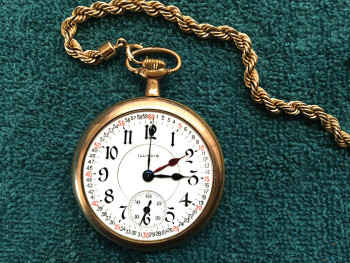
1911 Illinois Watch Company railroad pocket watch
Mark Pelletier and Chuck Weart
Although indeed our club members consider any time to be railroad time, this month we’ll talk about the historical effect which railroads had on timekeeping and railroad time which led to the time zones we have today. Years ago, people’s lives took place in a small area and distant activities could easily be measured just by date. Each locality operated on local or sun time – noon was whenever the sun was highest overhead wherever you were. It was different miles away, but that didn’t matter much since you could not interact with folks there without lengthy travel.
But the compressed travel which became available by railroad changed all that. You could interact with distant areas in terms of hours, not just days and it became important to be more specific about time. From the railroad’s perspective, the issue was even more meaningful. How could a schedule be published when each location was on a different time? More crucially, how could train movements be coordinated without any method of direct communication? No internet, no radio, no phone – only telegraph – but that was available only in fixed locations with a trained operator.
Almost all railroad lines were a single track, but with trains operating in both directions. So in order to coordinate train movements, instructions had to be very specific about location and time. By the early 1880s the need for standardized railroad time was apparent and in an uncharacteristically cooperative corporate effort, four time zones were established for all railroads on November 18, 1883. Characteristically, however, Congress only formalized this in 1918!
Thus the trainman’s most important tool was his watch. You absolutely had to have a watch – which you bought, by the way. The photo shows the watch my uncle, Frank Pelletier, used in his time with the U.S. Army on the White Pass & Yukon and later on the Chicago & North Western. It is somewhat uncommon in that it has two hour-hands. This was useful if your work took you across time zones or also to show Daylight Savings Time, which the railroad usually did not use internally – thus necessitating two time indications.
Each railroad had unique but similar standards for the function, accuracy and testing of approved watches. Watch producers developed lines of railroad watches. Trainmen were required to have their watches tested every 30 days by certified craftsmen who recorded the work on the owner’s watch maintenance log card.
The system worked because each station clock was always set from a telegraph signal sent by the railroad central office. Then all trainmen made sure their watches agreed with the station and with each other.
So thank the railroads, then check your GPS driven computerized smartphone so you can visit us on Tuesdays and Thursdays, 9:00 to 11:30 a.m. at Eagle’s Nest, Room 106. www.pcmrc.org
